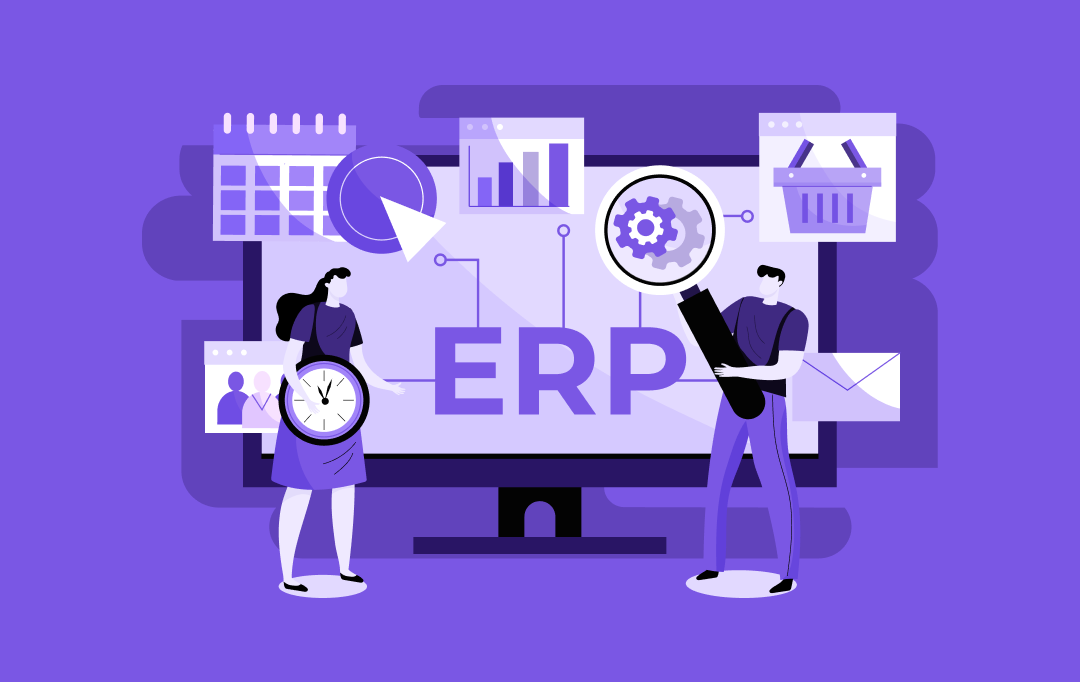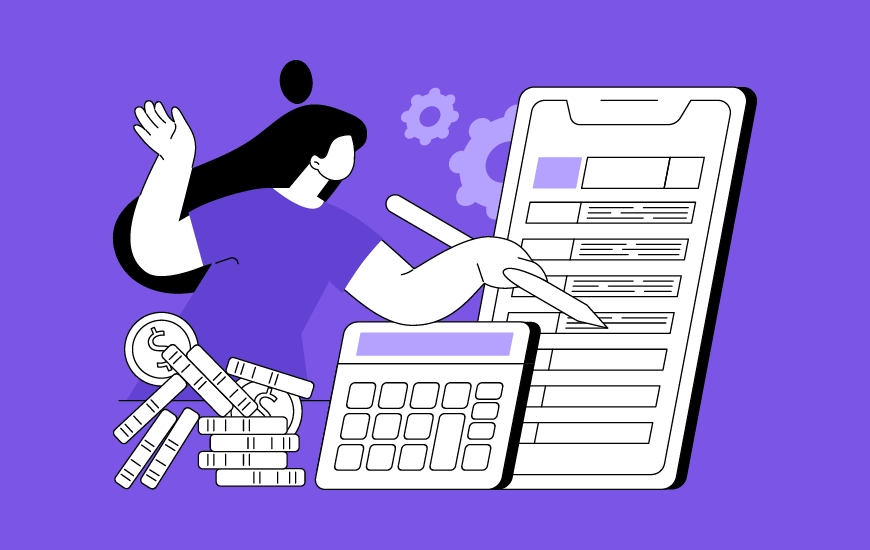- Why Should Corporates Migrate to a Cloud-Based Payroll System?
- Amplified Accessibility
- Better Efficiency
- Unmatched Scalability
- Predictable Expenses
- What are the Features of Cloud Based Payroll Software?
- Time-Tracking Integration
- Link with Corporate Bank
- Expense Management
- Employee Self-Service
- Payroll Reports
- Tax Filing
- Global Payroll
- On-Demand Payment
- Payroll Integration
- What Would the Cloud Payroll Software Development Cost Be?
- How to Make Money from a Payroll Software on the Cloud?
- Storage-Based
- Custom Builds
- APIs
- FAQs
The number of SMEs and enterprises that still rely on traditional payroll software is concerning. A quick search on the internet will get you a series of harrowing statistics about the lack of digital custom cloud payroll software development for enterprises and its grave repercussions. Like this –
- More than 34% of business owners still use spreadsheets to manage their payroll manually (QuickBooks)
- Low-performing organizations often need about 5-10 days to resolve a payroll error (APQC)
- 44% of employees would consider leaving their jobs after being paid incorrectly (SD Worx Survey)
- 72% of US employees would experience financial difficulty if their paychecks were delayed by one week (American Payroll Association).
These statistics are present in the same work environment, where it has been found that automation can reduce payroll processing costs by 80% (American Payroll Association).
It is only a matter of time before you realize the necessity of cloud-based payroll software development, don’t be the one to wait and then enter a competitive sector.
At Appinventiv, we understand how any business needs assurance from the market before investing their time and effort in a product, especially in a competitive space like payroll cloud application development. Having worked on over 12+ SaaS digital products from scratch, out of which 2 were payroll management software, we understand the imperative of transitioning to the cloud. Now is the optimal time for businesses (your customers) to embrace cloud payroll software, unlocking the myriad benefits this move entails.
Why Should Corporates Migrate to a Cloud-Based Payroll System?
While transitioning from a trusted, traditional payroll system to cloud-powered software involves navigating security and employee acceptance concerns, the opportunities presented by digitalization have encouraged businesses to choose the cloud.
Irrespective of what the push is, the benefits of cloud payroll software have become too impactful to ignore.

Amplified Accessibility
When you bring payroll software to the cloud, you can access it from anywhere with a mobile connection and internet. This way, the finance team will be easily able to access the payroll data and operations remotely, giving them the flexibility of performing critical payroll tasks in real-time, irrespective of the location. Incorporating AI in HR and payroll systems further helps in enhancing this accessibility, automating and streamlining the processes involved.
Better Efficiency
Corporate payroll management software development, no matter how well-built – when it doesn’t have cloud functionality – is not only time-intensive but also prone to errors. Compared to this, cloud payroll software development promises automation of complex and repetitive tasks such as deductions, tax calculations, and compliance monitoring. This precise-level automation lowers the chances of error and streamlines the payroll cycle.
[Also Read: How Much Does It Cost to Build a White-Label Tax Compliance Software]
Unmatched Scalability
As businesses move up towards scalability, traditional payroll systems tend to call for extensive help to help with adding new features and increasing complexity. Custom cloud payroll software development for enterprises is built to grow with companies’ size, enabling effortless addition of employees and features as the company evolves.
Predictable Expenses
Offline payroll systems tend to come with hidden charges like software maintenance, upgrades, and hardware maintenance. Compared to this, cloud based payroll systems work on a fixed subscription model, which enables companies to predict their expenses more accurately. Additionally, the absence of manual processes eliminates the risk of cost expenses emerging out of mistakes and compliance violations.
Powered by these reasons and the presence of several intuitive software available in the market, the industry has come to a stage where it is preparing to become US$ 13 Billion by 2031. Now, as an entrepreneur or an HR professional who has gathered the market potential of cloud based payroll software, giving companies what they are looking for will need a well-planned, feature-rich system.
What are the Features of Cloud Based Payroll Software?
The features linked with corporate payroll management software development can vary greatly from one business model to another. However, some have been recurring or default among all the custom cloud payroll software development for enterprises we have built to date.

Time-Tracking Integration
An integration with employees’ in and out times can greatly help businesses who are looking to build a cloud based payroll system for time-bound or contractual employees. This would eliminate the need for manual attendance entry, thus bettering the attendance accuracy and efficiency level.
Link with Corporate Bank
The functionality majorly falls on the employer’s side of cloud-based payroll software development deliverables, making it easy for the finance team to make salary disbursement a one-click process by linking the system with the corporate bank account. For the employees, this feature promises easy access to their paychecks and salary history.
Expense Management
Suppose your company works around reimbursable employee expenses such as lodging, travel, sales-related meets, meals, etc. In that case, integrating the expense management functionality becomes mandatory in your cloud payroll software development journey. With a proper document attachment component, the section can help with the automation of expense reports and payment cycles while improving reimbursement dispersal timelines.
Employee Self-Service
The self-service feature in your cloud-based payroll software development deliverable will come with two benefits – give employees the freedom to change their profile details like account number, address, or expense sheets and give employees access to the pay stubs, W-2 forms, and pay stubs.
End goal? The HR team can focus on building culture instead of being involved in clerical tasks.
Payroll Reports
Having a clear view of the payroll report is mandatory for C-suite executives. A good corporate payroll management software development solution should come with customized report-generation capabilities. The reason we say customized is that the reporting elements might vary from one company to another and will have different levels of integration requirements.
Tax Filing
The best cloud based payroll software has started coming up with solutions having in-built tax tables which get auto-updated as the tax slab and rate change. This takes estimates out of the dedication calculations while streamlining the tax filing process.
The payroll software development experts you partner with might also suggest creating a system where tax filing gets automated, and generate a W-2s form can be automatically generated.
[Also Read: How Much Does it Cost to Build a Tax Preparation App Like TurboTax?]
Global Payroll
With the world becoming one place, quite literally, businesses have started approaching the MNC tag with greater confidence. Supporting their vision, the payroll cloud application development industry has introduced a feature of global payroll where businesses can digitally solve the complications associated with hiring international employees and managing foreign currencies, time zones, and regulatory compliances.
On-Demand Payment
With corporates becoming more empathetic toward their employees’ satisfaction, some payroll software development processes are creating a functionality where the employees can request advance payments against their salary to meet their sudden, unplanned expenses. Accommodating this will require a system that runs salary calculations intuitively with minimal human intervention.
Payroll Integration
The connected digital environment that businesses operate in will need a cloud payroll solutions development capability that prioritizes integrations. Your software should seamlessly link with the HRM platform and for instances where the sales team salary component is linked with the conversions they make, there should be an effortless integration with the CRM system as well.
These features of cloud payroll software are only a high-level view of the offering businesses are promising through their software. The functionality sets you choose for your SaaS product would ultimately depend on your individual business goal and user need.
On that note, let us quickly look into two options you will have when venturing into the domain. Knowing which type of software you want to build will bring you one step closer to finding the best payroll software development company.
- Stand-alone payroll software
- HRMS-Payroll management system
As you can guess from the terminologies – a standalone payroll management software does not have any other functionalities like employee communication, policy access, absence management, etc. It is strictly limited to payroll. On the other hand, an HRMS payroll management system is wider in scope and has payroll as one of the functionalities.
After the feature list, the next critical element for businesses to know is the payroll management software development cost. This valuation would help decide the ROI of the developmental efforts.
What Would the Cloud Payroll Software Development Cost Be?
The cloud payroll software development cost can vary massively based on aspects such as features, complexity, technology stack, development team rates, and project management approach. Here’s a breakdown of the Software Development Life Cycle (SDLC) stages and associated costs.
*Disclaimer* – The payroll management software development cost mentioned here is only a rough estimate. The actual range can only be provided based on your exact business requirements.
Additionally, factors like scalability, security, and compliance requirements can also impact the cost of development. It’s essential to work closely with a software development services team to get a more accurate estimate tailored to your project’s needs.
Planning Phase
Requirements gathering and analysis: This involves understanding the client’s needs, defining features, and creating user stories.
Cost: $5,000 – $15,000
Design Phase
- Architectural design: Defining the system architecture, including database design, APIs, and system components.
- UI/UX design: Designing the user interface and user experience.
Cost: $10,000 – $30,000
Development Phase
- Frontend development: Implementing the user interface using technologies like HTML, CSS, and JavaScript.
- Backend development: Building the application logic, database integration, and server-side operations using languages like Python, Java, or Node.js.
- Integration: Connecting with third-party services like payment gateways, tax calculators, etc.
Cost: $30,000 – $100,000
Testing Phase
- Manual and automated testing: Quality assurance to ensure the software functions correctly and meets requirements.
- Bug fixing: Identifying and fixing any defects found during testing.
Cost: $10,000 – $30,000
Deployment Phase
Deployment to cloud infrastructure: Setting up servers, configuring databases, and deploying the application to cloud platforms like AWS, Azure, or Google Cloud.
Cost: $5,000 – $15,000
Maintenance and Support Phase
- Ongoing maintenance: Updating the software, fixing bugs, and addressing issues as they arise.
- Customer support: Providing support to users and addressing their queries and concerns.
Cost: Typically calculated as a percentage of the development cost annually, ranging from 20% to 30%.
Total estimated cost: $60,000 – $220,000
Now, while you will get a precise design and development range when you talk to our SaaS cloud consulting services experts, there is something that every first-time SaaS entrepreneur at the research stage will need to know – how to earn money from the cloud payroll software development efforts and what would get them a competitive edge in the market.
How to Make Money from a Payroll Software on the Cloud?
While the subscription model tops the list of getting revenue from a custom or white label cloud payroll software, there are several less talked about monetization models as well. Let’s look at them.

Storage-Based
The nature of custom cloud payroll software development for enterprises is such that it can get extremely data-intensive. Now while every SaaS platform comes with a certain storage space, you can offer different storage limits based on the users’ needs – something that will come attached with a cost.
Custom Builds
Adding custom elements for brands, such as their design system, usually comes as part and parcel of the subscription charge. You can take an extra step and offer custom integrations, drag-and-drop UI functionality, etc. to the users in return for a fixed amount charged on a per month or year basis.
APIs
There can be instances where your users would want to build software on your payroll software on cloud. Achieving this can be made possible by selling your product’s API on a subscription level or taking a commission for every API connection made.
It is important to note that you will be able to earn money through cloud-based payroll software development only when you have something extremely unique to offer. Here are some suggestions we make to our clients in this domain –
- Customizable Reporting and Dashboards: Provide users with the ability to create custom reports and dashboards tailored to their specific needs, with options to visualize payroll data in various formats (e.g., charts, graphs, tables). This empowers businesses to gain deeper insights into their payroll metrics and make data-driven decisions.
{Also Read: What are the best data visualization practices for businesses?} - Mobile App: Develop a mobile app that allows users to manage payroll tasks on the go, such as approving timesheets, processing payroll, and accessing payroll reports from their smartphones or tablets. Mobile accessibility in your cloud based payroll system would enhance convenience and flexibility for users.
- Blockchain-Based Security: Implement blockchain technology to enhance the security and integrity of payroll data, ensuring tamper-proof records and providing a transparent audit trail for all transactions.
- Real-Time Payroll Processing: Enable real-time payroll processing capabilities, allowing businesses to calculate and disburse payments instantly as soon as payroll data is submitted, rather than waiting for scheduled pay periods. This payroll software development feature can be especially beneficial for businesses with variable pay structures or gig economy workers.
- Voice-Activated Assistant: Ask your payroll management software development partner to incorporate voice-activated assistants (e.g., using natural language processing technology) to enable users to interact with the payroll software through voice commands, making it easier and more efficient to perform tasks hands-free.
FAQs
Q. What is a cloud payroll software?
A. Cloud payroll software refers to payroll management software that operates through cloud computing technology. This type of software allows businesses to manage their payroll processes online, accessing the system remotely via the Internet rather than installing and maintaining software on individual computers or servers.
Q. What are some common payroll software integration challenges?
A. While there are no integration challenges when you partner with us, some commonly occurring payroll software integration challenges include:
- Compatibility issues: Ensuring that the payroll software is compatible with existing systems, such as HRIS or accounting software.
- Data synchronization: Ensuring accurate and timely synchronization of data between different systems to prevent discrepancies.
- Security concerns: Ensuring data security and compliance with regulations when integrating payroll software with other systems.
- Customization requirements: Meeting specific business needs may require customization, which can complicate integration processes.
- Technical complexity: Integrating diverse systems with varying technologies and APIs can be technically challenging.
Q. How can you lower security risks in cloud-based payroll software development?
A. To lower the security risks in payroll management software development, you can consider these measures:
- Strong authentication: Implement multi-factor authentication (MFA) to add an extra layer of security beyond passwords.
- Data encryption: Encrypt sensitive payroll data both in transit and at rest to protect it from unauthorized access.
- Regular audits and monitoring: Conduct regular security audits and monitor system activities to detect and respond to any potential threats or breaches promptly.
- Access control: Limit access to payroll data to only authorized personnel and implement role-based access controls (RBAC) to ensure that users have appropriate levels of access.
- Regular software updates: Keep the payroll software and underlying infrastructure up-to-date with the latest security patches and updates to address any known vulnerabilities.
- Data backup and disaster recovery: Implement robust data backup and disaster recovery plans to ensure that payroll data can be restored in case of data loss or system failure.
- Compliance with regulations: Ensure compliance with relevant data protection regulations such as GDPR or CCPA to protect employee privacy and avoid legal repercussions.
Q. What factors impact the price of cloud-based payroll system development?
A. A cloud payroll software development company might quote anywhere between $60,000 – $220,000 for your product. This cost range would depend on several factors ranging from the extensiveness and complexity of feature sets, design system, number of platforms you will be building, and the team size, and location of your partnered cloud payroll software developers.
With this, we have looked into multiple aspects of payroll management software development – its necessity in the market, the must-have features, an approximate range of development costs, and the ways to get a competitive edge.
The fact that we have built over 12+ SaaS products and have dedicated experience in standalone payroll software development prepares us to be your preferred partner as you venture into the soon-to-be-competitive space as a new entrant.
Get in touch with our cloud payroll software development company today to initiate your project in under 48 hours!


- In just 2 mins you will get a response
- Your idea is 100% protected by our Non Disclosure Agreement.

Custom Development or White Label Solutions: Which is Right for Your Business?
Key takeaways: 77% of companies are prioritizing digital transformation; the right tech approach is crucial for staying competitive. Custom development offers tailored solutions for unique needs, flexibility, and long-term scalability. Whereas, white-label solutions provide quick market entry, cost-efficiency, and easy customization for standard needs. Appinventiv’s expertise helps you navigate custom development vs white-label to choose…

ERP Integration in Australia - Why It Is Essential and How to Do It Right
Key takeaways: ERP integration enables operational efficiency, reduced costs, and enhanced decision-making. Healthcare, finance, manufacturing, retail, and all the other sectors are benefiting from ERP integrations in Australia. While ERP integration can be costly, ranging from AUD 45,000 - AUD 450,000, it leads to significant long-term savings and scalability. Compliance with Australian regulations is critical,…

Predictive Analytics Software Development - Features, Benefits, Use Cases, Process, and Cost
Key Takeaways Predictive analytics helps businesses shift from “what has happened” to "what will happen," enabling proactive strategies rather than reactive ones. Real-time analytics and AI integration are driving the growth of predictive analytics, making it more accurate, accessible, and critical for business success. Custom predictive analytics solutions can enhance customer satisfaction, reduce costs, and…


















